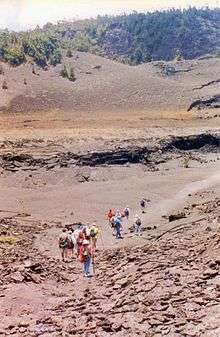Kīlauea Iki
Coordinates: 19°24.833′N 155°14.785′W / 19.413883°N 155.246417°W

Kīlauea Iki is a pit crater that is next to the main summit caldera of Kīlauea on the island of Hawaiʻi in the Hawaiian Islands.
15th century eruption
Lava tubes associated with Kīlauea Iki are responsible for the vast ʻAilāʻau eruption, carbon 14 dated from circa 1445 and erupting continuously for approximately 50 years, which blanketed much of what is now Puna District with 5.2 ± 0.8 km3 of basalt lava.[1][2]
1959 eruption
In August 1959, a swarm of deep earthquakes was detected by the Hawaiian Volcano Observatory. In October it was indicated by seismographs that Kilauea summit was filling with magma. This formed a new lava shield, named Pu'u Pua'i (gushing hill).
Lava fountain
Some of the most impressive parts of the eruption were the lava fountains that flowed from Puʻu Puaʻi. By November 17, the fountain was reaching 60–80 meters tall with occasional bursts as high as 180 meters. The fountain grew to over 320 meters on November 18. On November 21, the lava lake was over a meter deep over the vent causing ripples across the surface of the lava lake causing lava on the shores to break like waves on a beach. At 7:25 p.m. local time on November 21, the fountain went from 210 meters tall to a few gas bubbles in less than 40 seconds. Some of the fountains were extraordinarily high, reaching nearly 580 m (1,900 ft), among the highest ever recorded.[3]

Lava drainback


The first episode had 31 million cubic meters of lava flow into Kīlauea Iki with 1 million cubic meters draining back. During the following episodes, a total of 71 million cubic meters of lava was ejected during a month-long eruption that stopped on December 20, 1959. Only 8 million cubic meters of lava remained, 63 million cubic meters of lava drained back into Kīlauea magma reservoir. Often the lava drainback had a higher rate of flow than the eruptions.
On December 15, the highest flow of lava was measured at 1.45 million cubic meters per hour. With every filling and draining of the lava lake, a 'black ledge' was formed along the rim of the crater which is now 15–60 meters wide and 15 meters tall. During lava drainbacks, a giant counter-clockwise whirlpool would form.
Tourism
Drivers may view Kīlauea Iki from either a lookout point or the trailhead parking lot. Guests can hike across Kīlauea Iki by descending from Byron Ledge, which overlooks the crater. The trail crosses the floor of the crater, which once was a lake of lava. Even after 50 years, the parts of the surface are still warm to the touch. Rainwater seeps into the cracks and makes contact with the extremely hot rock below and steam is emitted from various surface cracks. The steam and some rocks are hot enough to cause serious burns.
References
External links
- Summit Eruption of Kīlauea Volcano, in Kīlauea Iki Crater
- US Department of Defense film of the 1959 volcano eruption of Kilauea Iki Crater
- The short film "Volcano Eruptions (1959)" is available for free download at the Internet Archive
| Wikimedia Commons has media related to Kīlauea Iki. |
